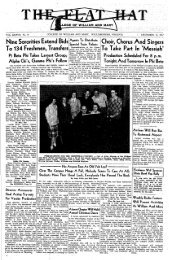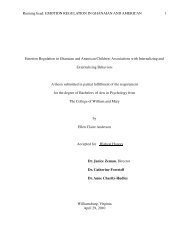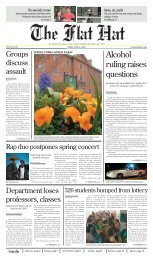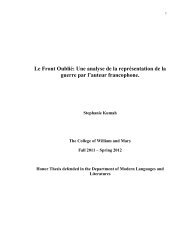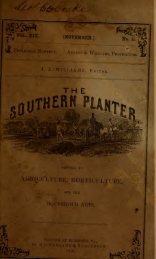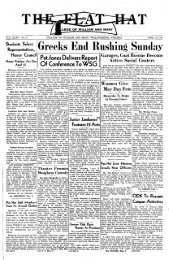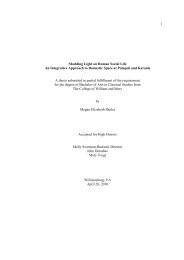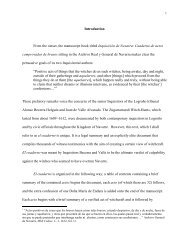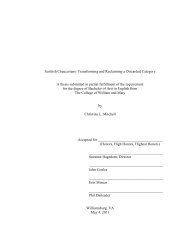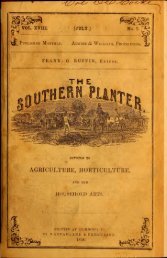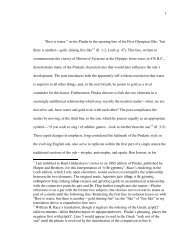Southern planter - The W&M Digital Archive
Southern planter - The W&M Digital Archive
Southern planter - The W&M Digital Archive
You also want an ePaper? Increase the reach of your titles
YUMPU automatically turns print PDFs into web optimized ePapers that Google loves.
859.] THE SOUTHERN PLANTER. 445<br />
iavc found that this also gives me another<br />
.dvantage, for the deeper I get my farm,<br />
he higher my grain grows, so I gain in<br />
10th directions, and by this means I reckon<br />
've got at least thirty per cent, more availa-<br />
»le space than formerly; at any rate my<br />
cventy dollars per acre land would now<br />
ring me ninety dollars—but I hav'nt got<br />
o the bottom nor top of it yet, and I mean<br />
o stick to it.<br />
I have found by experiment that it is<br />
•est to run the plow deeper when raising<br />
ats and winter grain, rather than when<br />
ireaking up for corn.<br />
Corn is an aristocratic plant as you might<br />
mow by its tasseled head, silk gloves, and<br />
3ng ears, and like such gentry it must have<br />
;ood nursing in the beginning, and the best<br />
iving the land will afford. It sends its<br />
oots about, near the surface where it can<br />
ind plenty of food, and where they can<br />
;row comfortably near the warm surface,<br />
f you plow deep enough to turn up the<br />
old and hard subsoil, the seed planted at<br />
he usual depth will germinate where they<br />
oeet With a cold reception, especially if<br />
he season be wet. Scarce any crop seems<br />
o be more benefitted by an early start, or to<br />
•e more injured by a slow, painful growth in<br />
n the commencement. <strong>The</strong> young plants<br />
eem to be discouraged, and not having<br />
brce enough to dig down to find a good<br />
iving, they are apt to grow up sickly.<br />
In cultivating this crop I have, therefore,<br />
>ractised turning up all the soil, gaging my<br />
>low to run just on the subsoil, and let the<br />
:orn have the full benefit of the manure<br />
,nd clover which were plowed under. <strong>The</strong><br />
:rop is followed with oats, which can stand<br />
, cold and wet soil better. <strong>The</strong>n I drive<br />
he plow deeper, about an inch, as you re-<br />
:ommended in your last number. <strong>The</strong> soil,<br />
nellowed by the previous hoed crops, gives<br />
he oats a good chance, and they bear the<br />
ubsoil mixture on the top quite well. <strong>The</strong><br />
bllowing crop with me is rye and seeded<br />
lown with clover and timothy, especially<br />
he former. Now I give the gage another<br />
urn, and bring up say another inch of sub-<br />
loil, and the rye and the clover dig for<br />
heir living—and mine—most admirably.<br />
. « • • > ><br />
dotation and Deep Soil—A Corn Experiment.<br />
Regular rotation of crops and deep plowng<br />
are working wonders upon some of the<br />
)ld and long-worn farms of New England<br />
In the discussions before the Maine State<br />
Board of Agriculture, which met at the<br />
seat of government in January, many of<br />
the delegates bore striking and uniform testimony<br />
to the value of both these practices,<br />
especially upon land* that had been cropped<br />
hard. One of the members mentioned a field<br />
of fifteen acres, "badly bound out," which<br />
was plowed three inches deeper than ever before,<br />
and after an application of three bushels<br />
of plaster of Paris, produced a yield of<br />
600 bushels of oats This is forty bushels<br />
to the acre. Another reported a yield 82<br />
bushels shelled corn per acre—56 lbs., to<br />
the bushel, from a field similarly treated.<br />
Results very much like these could be<br />
obtained from many of the old fields in<br />
Kentucky, which now grow nothing but<br />
sedge and briars, if deeply plowed, and the<br />
application of plaster were substituted by a<br />
generous quantity of barn-yard manure or a<br />
compost of which the base should be stable<br />
dung and scrapings from the woods.<br />
We have our mind's eye now upon an<br />
old field twelve miles from Louisville, which<br />
was treated in this manner three years ago,<br />
and gave a yield of corn in return that much<br />
more than paid expenses. Without further<br />
preparation it was seeded to grass, sown<br />
upon the corn stubble, and will this season<br />
be more than fair pasture or meadow, for one<br />
or the other of which it is designed. <strong>The</strong><br />
corn in this experiment was manured in<br />
the hill.<br />
Our farmers complain of the great labor<br />
and heavy cost of such experiments. But<br />
such complaints are without reason. Every<br />
farmer who keeps merely two or three<br />
horses, four or, five cattle, a half dozen<br />
hogs, if he will only litter his stalls, pens<br />
and .barn-yard, with the cheap litter afforded<br />
by the woods a short distance from his.<br />
dwelling-house, in quantities enough to furnish<br />
his animals with comfortable bedding,<br />
he can have every year, by planting time<br />
in the spring, a mountain of compost such<br />
as we have described that will perfectly as-<br />
tonish his own eyes.<br />
So much for the cost of that part of the<br />
experiment. It really costs nothing, for it<br />
will pay for itself in the increased comfort<br />
supplied to his stock, and the diminished<br />
quantity of food necessary to carry them<br />
through the winter. As for the labor and<br />
expense of hauling out, that is not very formidable,<br />
when you post up and look the<br />
thing right in the face.



